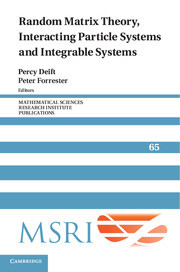Description
Random Matrix Theory, Interacting Particle Systems, and Integrable Systems
Mathematical Sciences Research Institute Publications Series
Coordinators: Deift Percy, Forrester Peter
This volume includes review articles and research contributions on long-standing questions on universalities of Wigner matrices and beta-ensembles.
Language: English
Subject for Random Matrix Theory, Interacting Particle Systems, and...:
Publication date: 12-2014
540 p. · 3x23.4 cm · Hardback
540 p. · 3x23.4 cm · Hardback
Description
/li>Contents
/li>Biography
/li>
Random matrix theory is at the intersection of linear algebra, probability theory and integrable systems, and has a wide range of applications in physics, engineering, multivariate statistics and beyond. This volume is based on a Fall 2010 MSRI program which generated the solution of long-standing questions on universalities of Wigner matrices and beta-ensembles and opened new research directions especially in relation to the KPZ universality class of interacting particle systems and low-rank perturbations. The book contains review articles and research contributions on all these topics, in addition to other core aspects of random matrix theory such as integrability and free probability theory. It will give both established and new researchers insights into the most recent advances in the field and the connections among many subfields.
Preface; 1. Universality conjecture for all Airy, sine and Bessel kernels in the complex plane Gernot Akemann and Michael Phillips; 2. On a relationship between high rank cases and rank one cases of Hermitian random matrix models with external source Jinho Baik and Dong Wang; 3. Riemann–Hilbert approach to the six-vertex model Pavel Bleher and Karl Liechty; 4. CLT for spectra of submatrices of Wigner random matrices, II: stochastic evolution Alexei Borodin; 5. Critical asymptotic behavior for the Korteweg–de Vries equation and in random matrix theory Tom Claeys and Tamara Grava; 6. On the asymptotics of a Toeplitz determinant with singularities Percy Deift, Alexander Its and Igor Krasovsky; 7. Asymptotic analysis of the two-matrix model with a quartic potential Maurice Duits, Arno B. J. Kuijlaars and Man Yue Mo; 8. Conservation laws of random matrix theory Nicholas M. Ercolani; 9. Asymptotics of spacing distributions fifty years later Peter Forrester; 10. Applications of random matrix theory for sensor array imaging with measurement noise Josselin Garnier and Knut Solna; 11. Convolution symmetries of integrable hierarchies, matrix models and τ-functions John Harnad and Alexander Orlov; 12. Universality limits via 'old style' analysis Doron Lubinsky; 13. Fluctuations and large deviations of some perturbed random matrices Mylene Maida; 14. Three lectures on free probability Jonathan Novak; 15. Whittaker functions and related stochastic processes Neil O'Connell; 16. How long does it take to compute the eigenvalues of a random symmetric matrix? Christian Pfrang, Percy Deift and Govind Menon; 17. Exact solutions of the Kardar–Parisi–Zhang equation and weak universality for directed random polymers Jeremy Quastel; 18. Replica analysis of the one-dimensional KPZ equation Tomohiro Sasamoto; 19. Asymptotic expansions for β matrix models and their applications to the universality conjecture Mariya Shcherbina; 20. KPZ scaling theory and the semidiscrete directed polymer model Herbert Spohn; 21. Experimental realization of Tracy–Widom distributions and beyond: KPZ interfaces in turbulent liquid crystal Kazumasa Takeuchi; 22. Random matrices: the four-moment theorem for Wigner ensembles Terence Tao and Van Vu.
Percy Deift is a professor at the Courant Institute of Mathematical Sciences, New York University. He is the author of Orthogonal Polynomials and Random Matrices: A Riemann-Hilbert Approach (1999) and was elected to the US National Academy of Sciences in 2009.
Peter J. Forrester is a professor in the Department of Mathematics and Statistics at the University of Melbourne, Victoria. He is the author of Log-Gases and Random Matrices (2010) and was elected to the Australian Academy of Science in 2004.
Peter J. Forrester is a professor in the Department of Mathematics and Statistics at the University of Melbourne, Victoria. He is the author of Log-Gases and Random Matrices (2010) and was elected to the Australian Academy of Science in 2004.
© 2024 LAVOISIER S.A.S.




